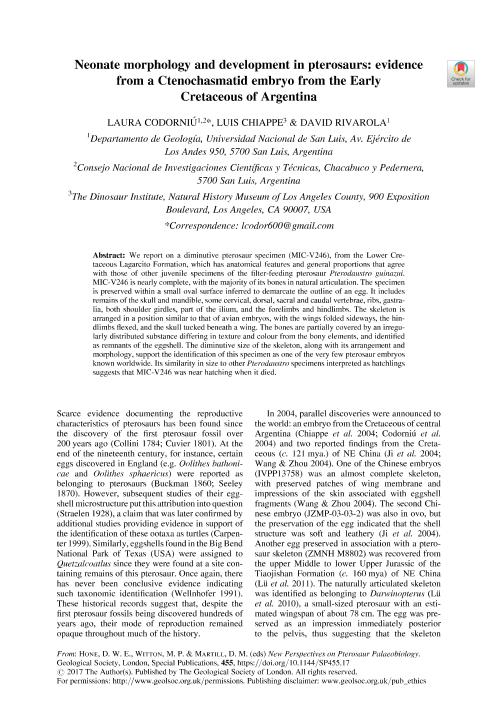Artículo
Neonate morphology and development in pterosaurs: Evidence from a ctenochasmatid embryo from the Early Cretaceous of Argentina
Fecha de publicación:
09/2017
Editorial:
Geological Society of America
Revista:
Geological Society of London Special Publication
ISSN:
0305-8719
Idioma:
Inglés
Tipo de recurso:
Artículo publicado
Clasificación temática:
Resumen
We report on a diminutive pterosaur specimen (MIC-V246) from the Lower Cretaceous Lagarcito Formation, that has anatomical features and general proportions which agree with those of other juvenile specimens of the filter-feeding pterosaur Pterodaustro guinazui. MIC-V246 is nearly complete with the majority of its bones in natural articulation. The specimen is preserved within a small oval surface inferred to demarcate the outline of an egg. It includes remains of the skull and mandible, some cervical, dorsal, sacral, and caudal vertebrae, ribs, gastralia, both shoulder girdles, part of the ilium, and the forelimbs and hindlimbs. The skeleton is arranged in a position similar to that of avian embryos, with the wings folded sideways, the hindlimbs flexed, and the skull tucked beneath a wing. The bones are partially covered by an irregularly distributed substance differing in texture and color from the bony elements and identified as remnants of the eggshell. The diminutive size of the skeleton, along with its arrangement and morphology support the identification of this specimen as one of the very few pterosaur embryos known worldwide. Its similarity in size to other Pterodaustro specimens interpreted as hatchlings suggests that MIC-V246 was near hatching when it died.
Palabras clave:
PTEROSAURIA
,
NEONATE MORPHOLOGY
,
CRETACEOUS
,
ARGENTINA
Archivos asociados
Licencia
Identificadores
Colecciones
Articulos(CCT - SAN LUIS)
Articulos de CTRO.CIENTIFICO TECNOL.CONICET - SAN LUIS
Articulos de CTRO.CIENTIFICO TECNOL.CONICET - SAN LUIS
Citación
Codorniú Dominguez, Laura Susana; Chiappe, Luis; Rivarola, David Luciano; Neonate morphology and development in pterosaurs: Evidence from a ctenochasmatid embryo from the Early Cretaceous of Argentina; Geological Society of America; Geological Society of London Special Publication; 455; 9-2017; 1-12
Compartir
Altmétricas




